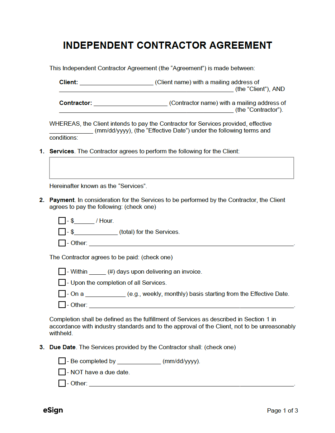
An independent contractor agreement establishes the terms of service between a contractor and the hiring client. The document covers a wide range of topics, the most important being the services the contractor will provide, compensation, and when or how the contract terminates.
An independent contractor agreement establishes the terms of service between a contractor and the hiring client. The document covers a wide range of topics, the most important being the services the contractor will provide, compensation, and when or how the contract terminates.
PDF Download
An independent contractor agreement establishes the terms of service between a contractor and the hiring client. The document covers a wide range of topics, the most important being the services the contractor will provide, compensation, and when or how the contract terminates.
4.7 | 76 Ratings Downloads: 7,469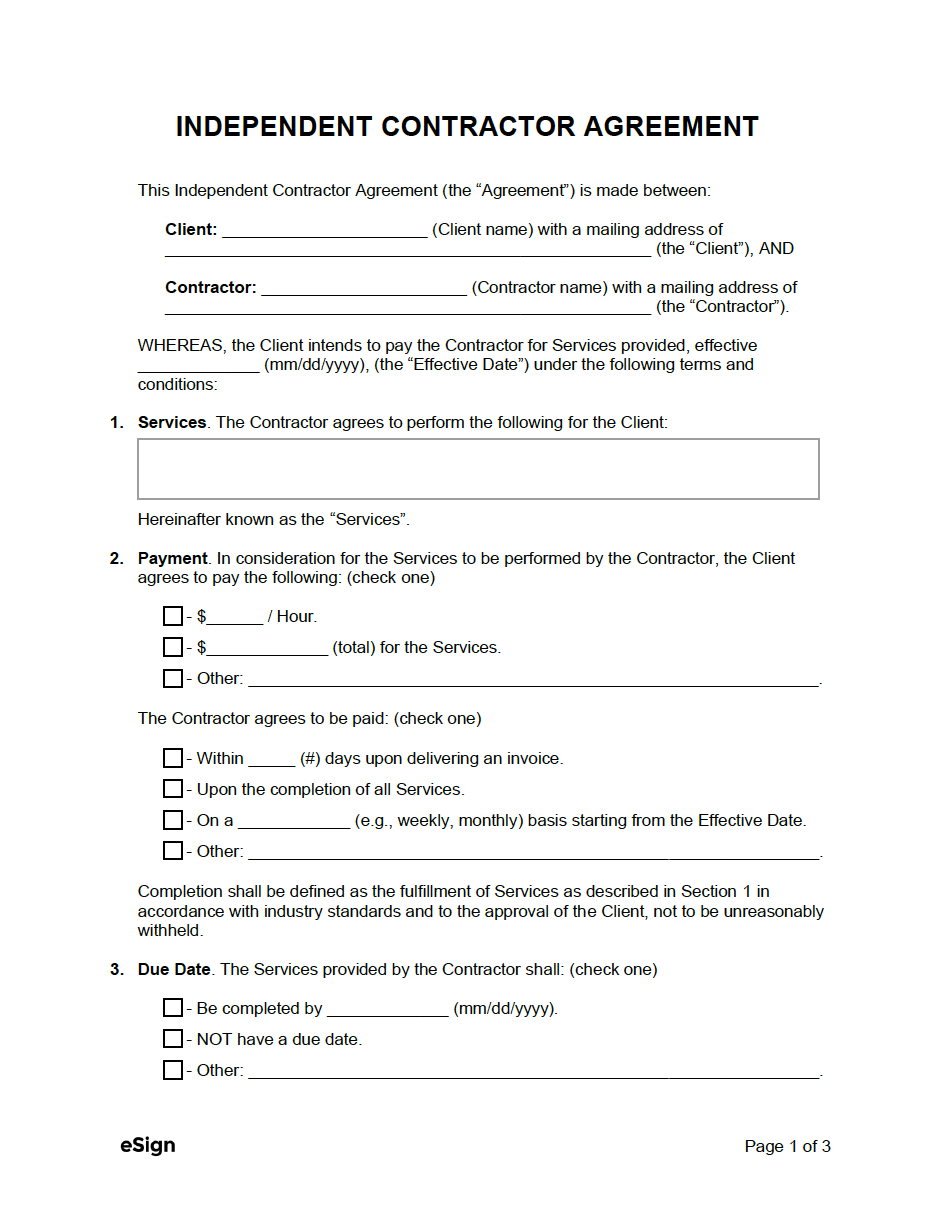
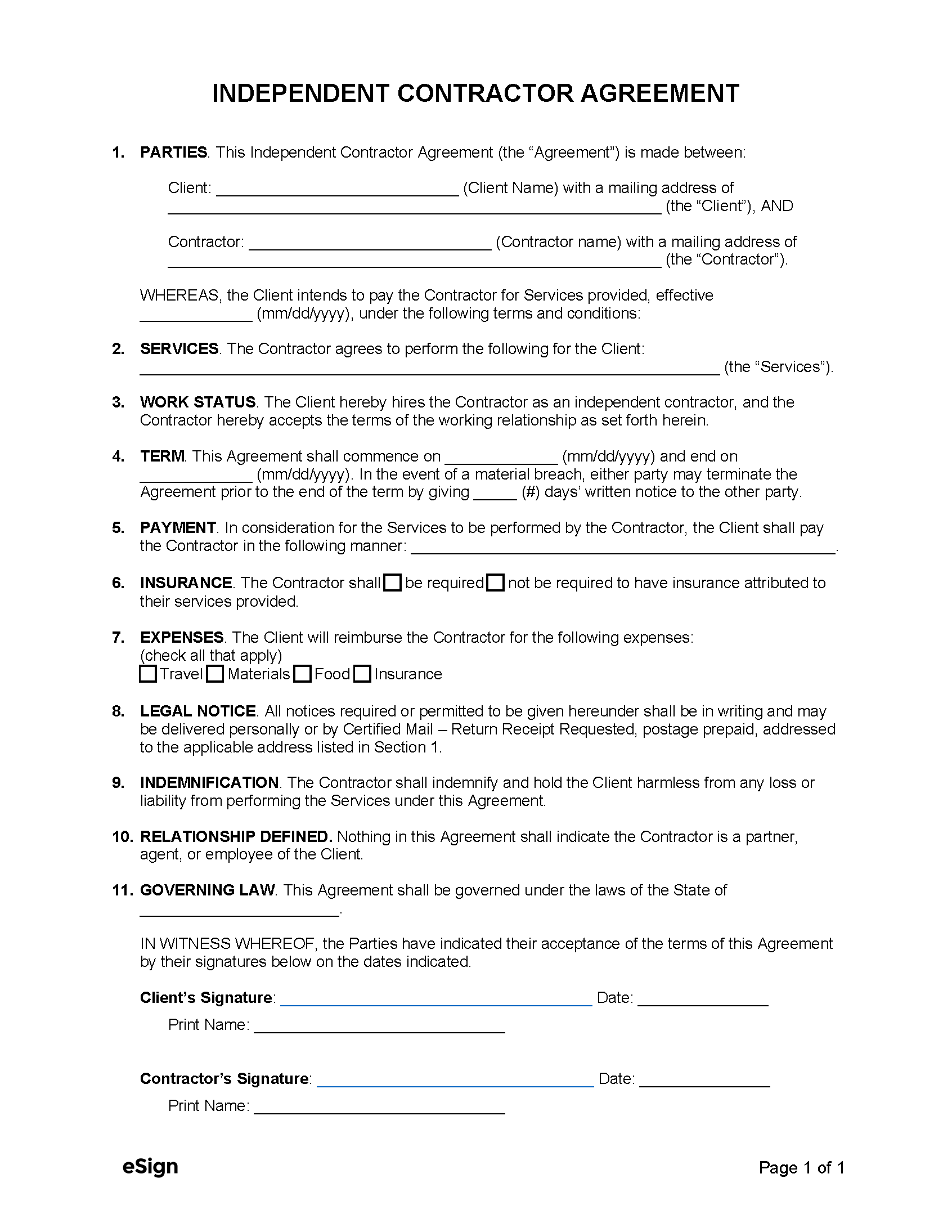
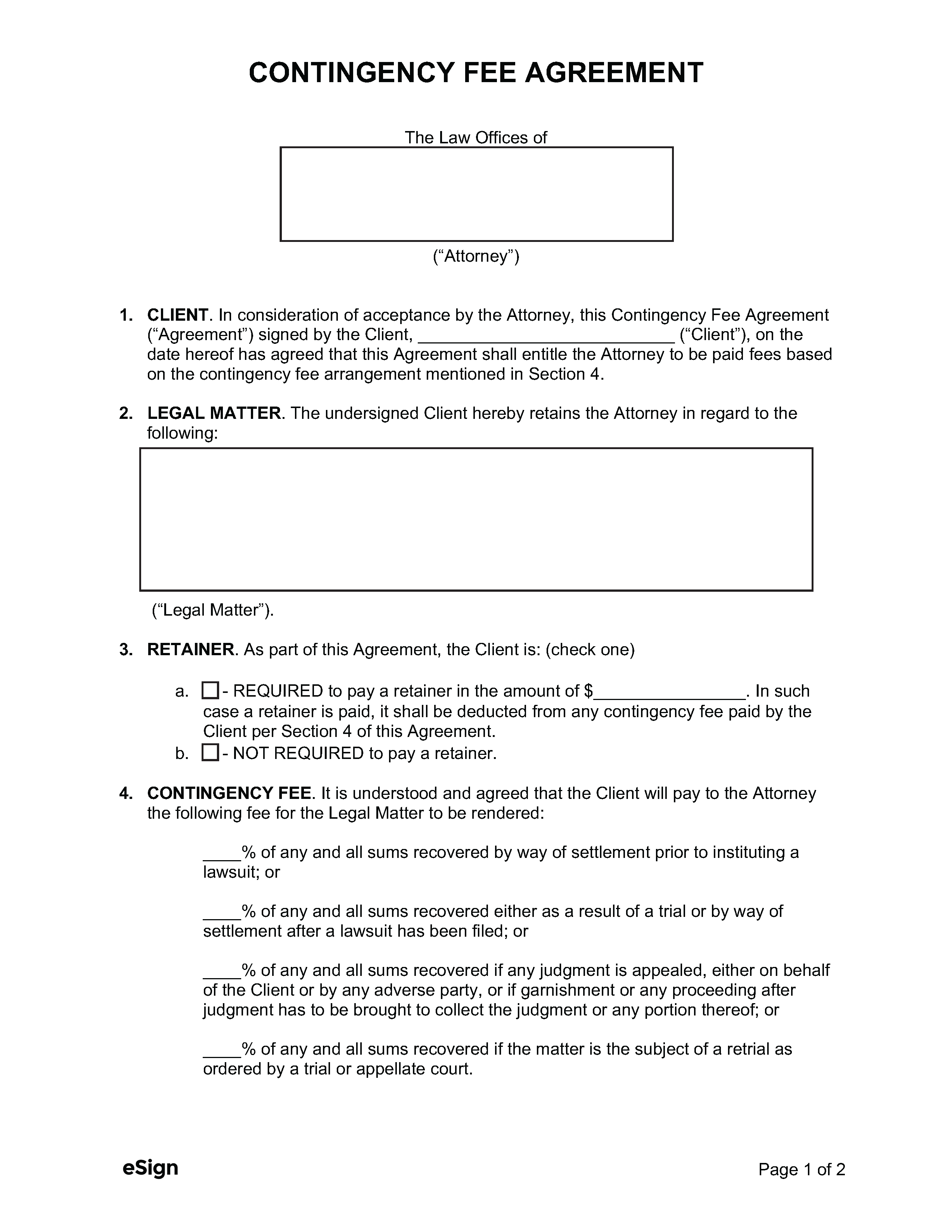
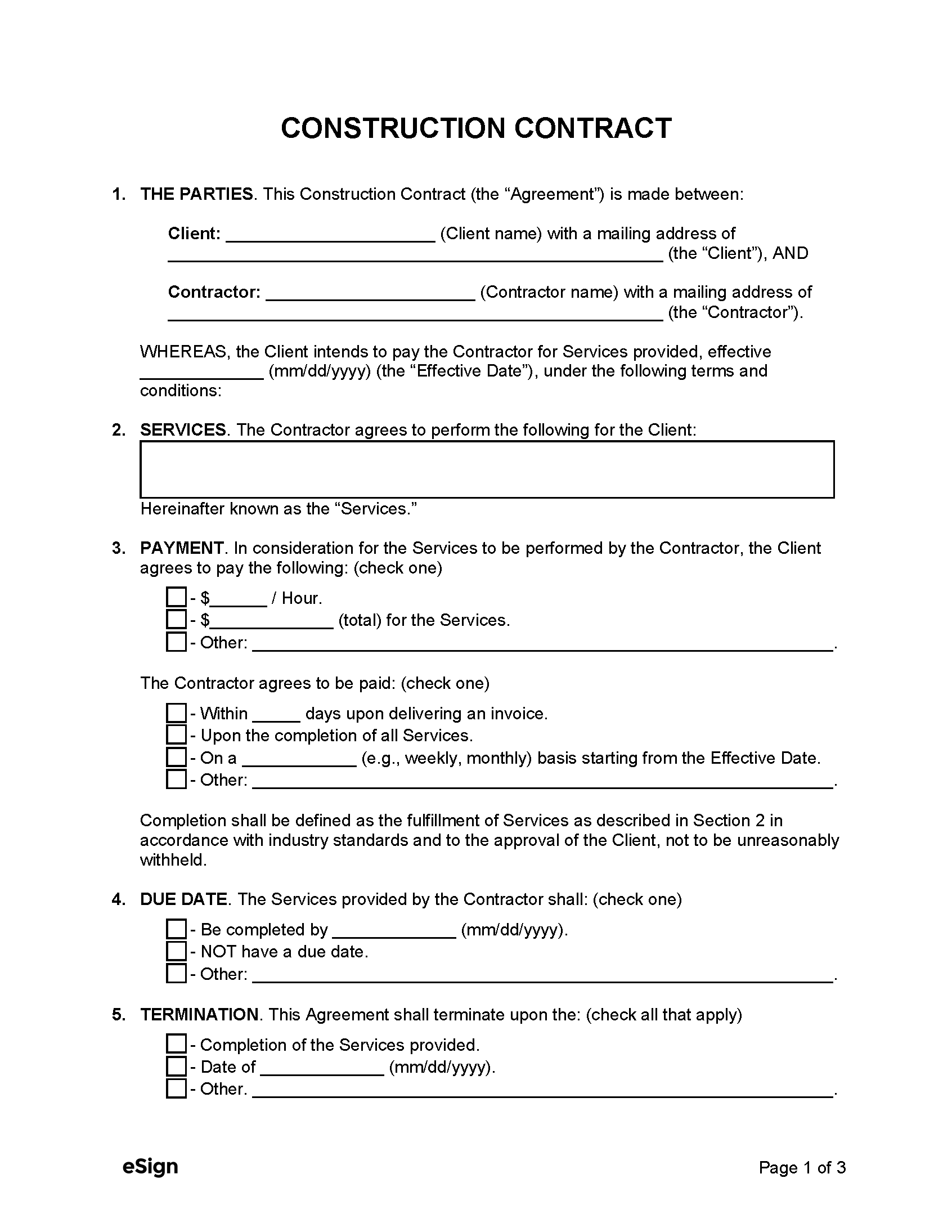
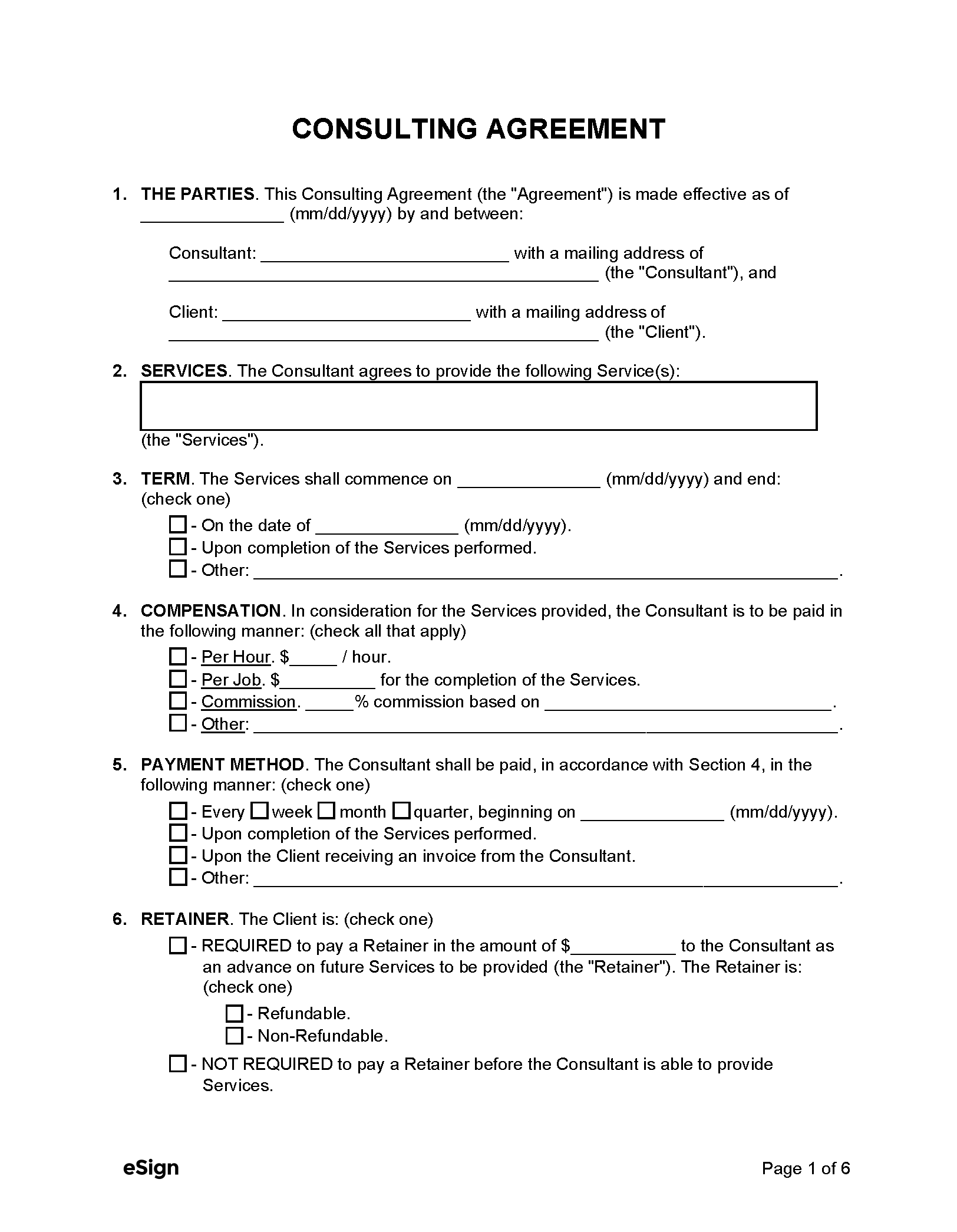
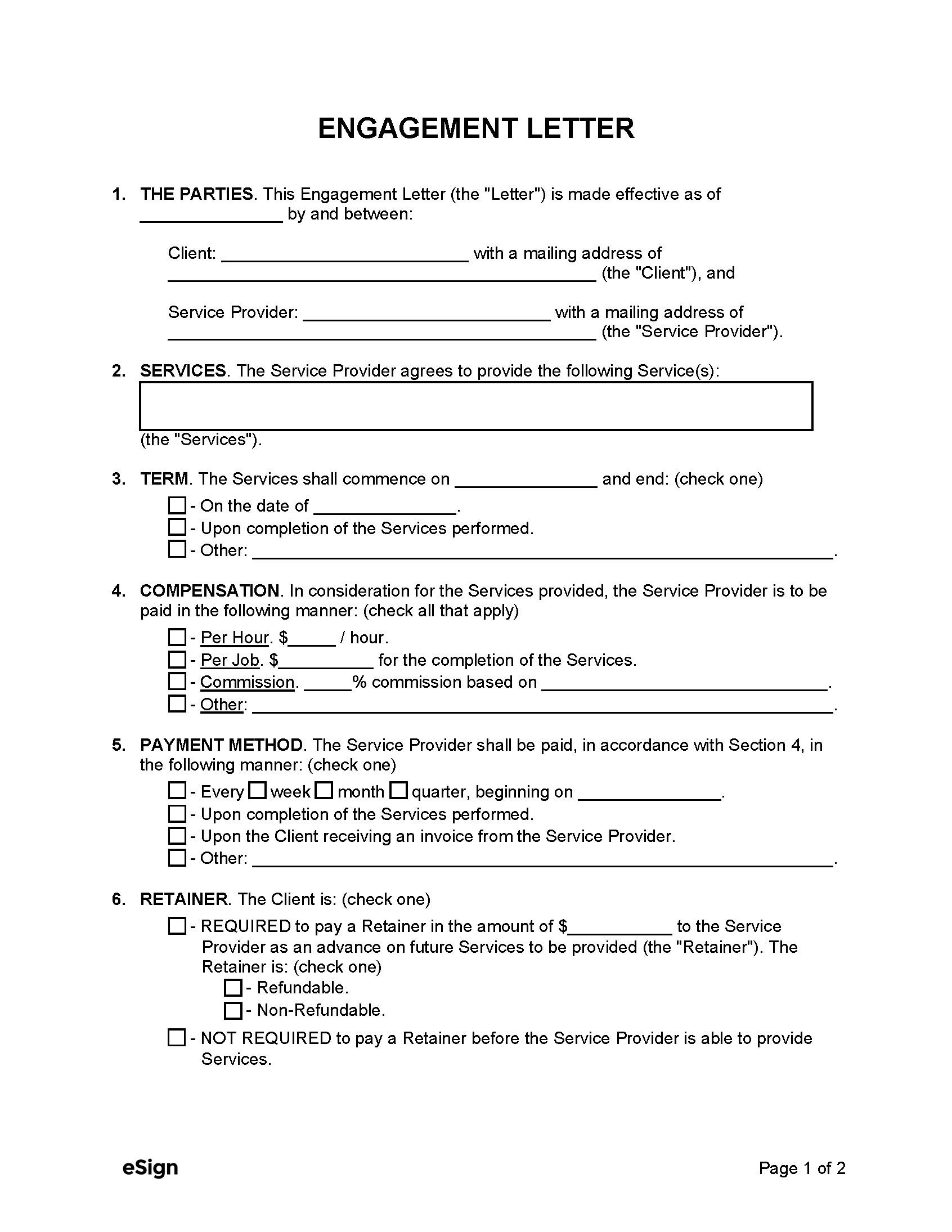
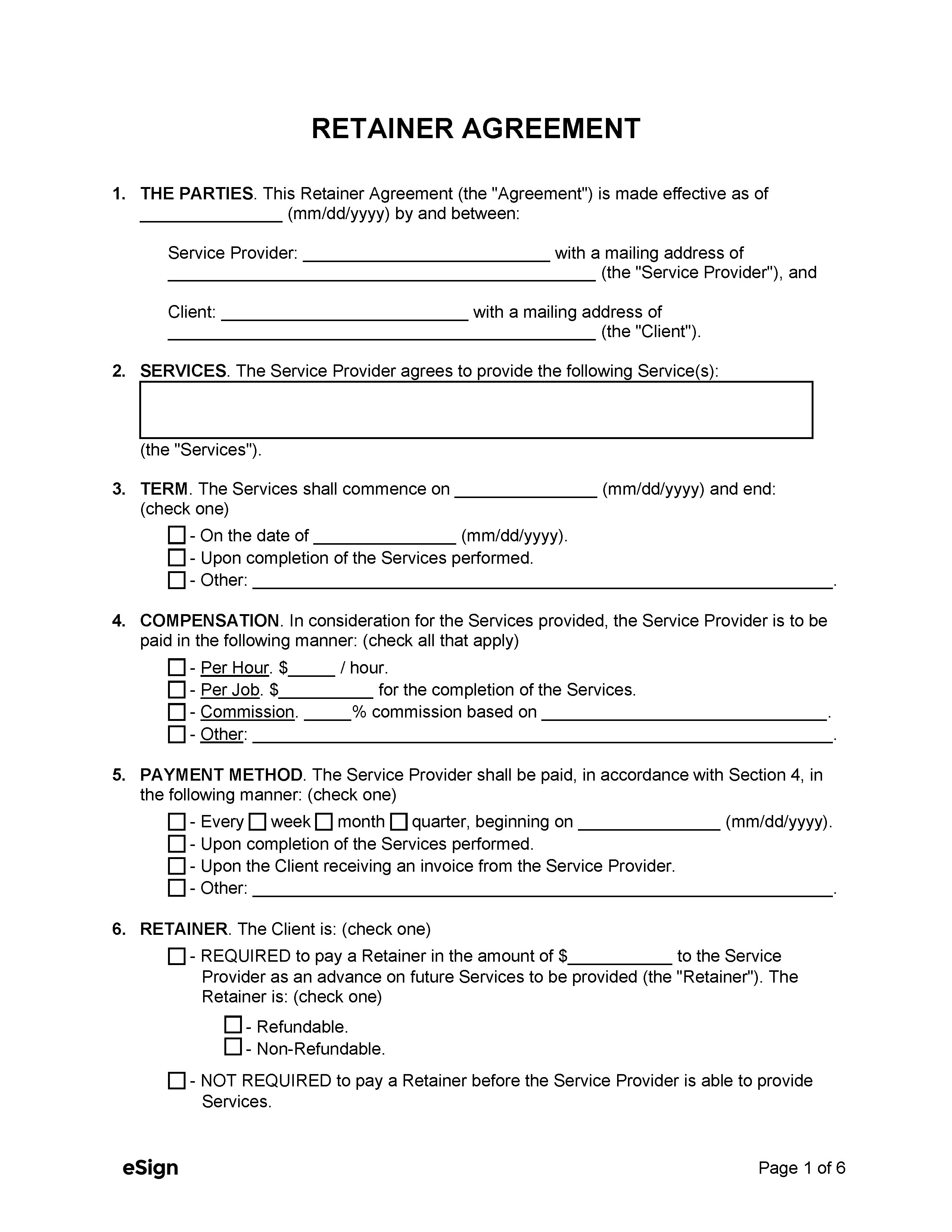
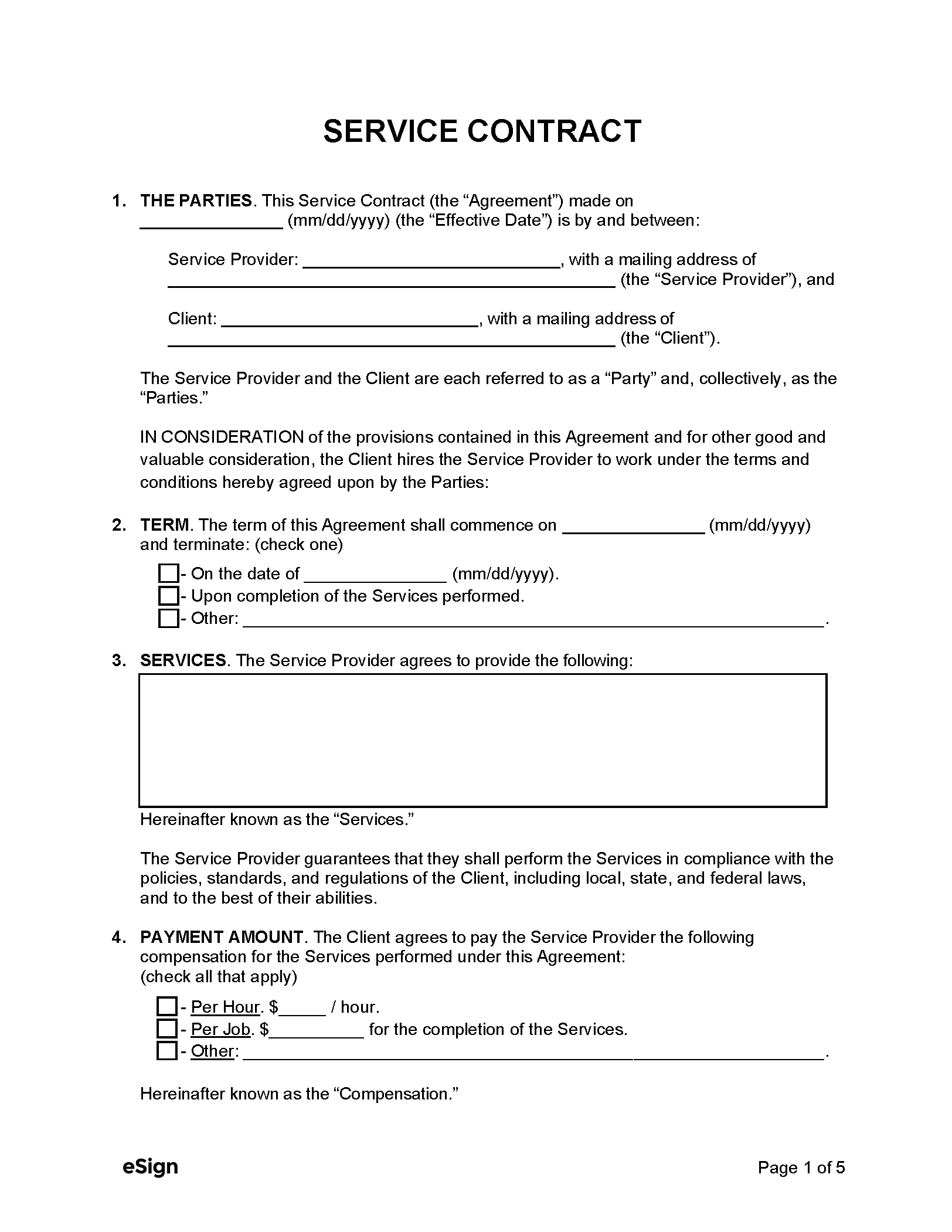
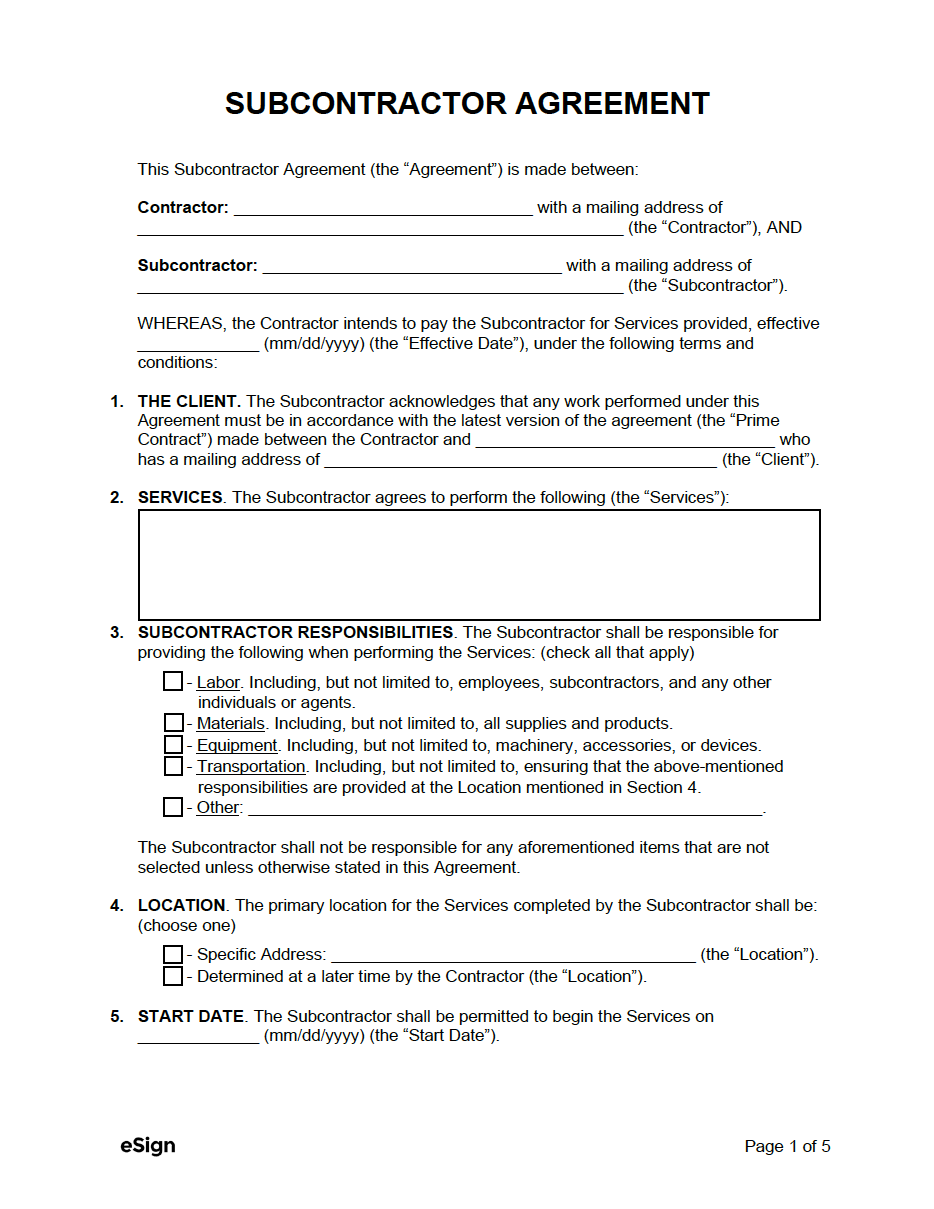
An independent contractor (also known as a freelancer) is a self-employed professional that offers one or more services in exchange for payment. Unlike an employee, independent contractors are free from any company-established rules and regulations, including the manner in which they do their job. In other words, freelancers are only required to deliver the services they agreed to perform – but what they do (and how they do it) is solely up to them.
The freedom provided to contractors doesn’t come without consequence, however. Insurance, worker’s comp, paid vacation, sick leave, and a stable, consistent salary are a few of the benefits freelancers give up by being self-employed. Additionally, freelancers are responsible for deducting and paying their own taxes.
“…independent contractors are entities hired by employers to accomplish certain tasks but do not have the right of control over those entities. Independent contractors tend to have specialized skills or knowledge and work for many employers.”
The IRS designates workers as either an employee or a contractor. As established above, contractors are responsible for reporting their own income (and filing taxes). In the eyes of the IRS, a person is considered self-employed if they meet the majority of the requirements written out in three (3) categories:
The IRS also provides a list of professions that are viewed as independent contractors by default. These professions include accountants, auctioneers, construction contractors/subcontractors, dentists, doctors, lawyers, public stenographers, and veterinarians.
It’s important to note that a person does not need to check every single box in order to be classified as a contractor. Because the lines may be blurry between the two types, the employer will need to choose the work classification that fits best.
Employee or contractor.. still can’t decide?
If an employer can’t decide if a hired person is an employee or a contractor, they can complete and file IRS Form SS-8, (“Determination of Worker Status for Purposes of Federal Employment Taxes and Income Tax Withholding”).
There are two (2) major tax-related forms that are by freelancers and those that hire them. These forms are:
Form W9 is a form that is given to a contractor (from a business) before beginning work. The freelancer will then fill out the form and provide it to the hiring business for their records. Form W9 is not filed with the IRS but is used to provide the client with detailed information on the freelancer. This allows the client to confirm who the contractor is and use the info provided in the form to later complete and file Form 1099-NEC (filed with the IRS).
Form 1099-NEC is a tax form used to inform the IRS of the amount a freelancer was paid in a year. A single form is completed for each contractor that was hired.
Before 2020, businesses would need to report income via the IRS form 1099-MISC. The IRS now requires Form 1099-NEC to be completed going forward instead. The form is completed by the employer, who will then need to file a copy with the IRS as well as send a copy to the contractor for their own tax reporting.
It needs to be completed if a contractor was paid $600 or more during the course of a year.
An independent contractor agreement is a form that spells out the working relationship between a freelancer and the company hiring them. It covers all the details of how the two will work together, including the services that will be performed, how payment will be made, when the agreement will end, and more. The agreement is a necessity anytime a company is hiring a non-employee, regardless of how long the term of the contract is.
The goal of the contract is to:
To accomplish this, the agreement should include the following clauses:
Establishes the names and addresses of the contractor and the hiring entity (client). The client’s full entity name should be written (not the name of the person completing the form). Additionally, the address written should be the company’s principal office address – not the location where work will be performed (unless both are the same).
The services should be described in one (1) to two (2) sentences, providing enough information to convey the general duties of why the contractor was hired. For example, if the contractor was hired to repaint a gym’s walls, the definition could be:
“To paint all interior walls of the gymnasium (Paul’s Fitness). Includes prepping walls, mixing paint, applying necessary coat(s), overseeing subcontractors, and seeing the job through to completion.”
Establishing how the contractor will be paid (and when) is essential to forming a complete agreement. While the exact contents of the section do not matter, it should convey:
The agreement needs to specify the situation(s) in which termination will occur. While the majority of contracts terminate upon the successful completion of all service(s), the client may want to include a termination date to ensure they have the means of ending the contract should the contractor take longer than expected.
This section details what (if any) expenses will be paid for by an employer. Expenses refer to costs that were incurred as a result of the service(s) performed by a contractor. For example, if a contractor was hired to purchase and install a complex (and costly) generator, the contractor would most likely require reimbursement from the business for the full cost of the equipment.
Regardless of what is written in the contract, all contractors should hold insurance to protect themselves, their employees, and the property they’re working on should an incident occur. The agreement should include a clause referencing the contractor’s commitment to hold insurance prior to beginning work. Where agreements can differ is if there is a required minimum amount the contractor must hold (such as a $1,000,000 single limit) or if they can have any limit so long it complies with the laws of the state where work is occurring.
The contract should include a clause that confirms the hired contractor (and any of their employees) are deemed independent contractors per the IRS. While this doesn’t provide clients with an “out” if they’re trying to unlawfully classify an employee as a contractor, it provides the client with the contractor’s confirmation that they’re performing their services on a contracted basis and that they understand where they stand with the client.
In addition to the above-named clauses, the contract should contain the types of stipulations that are standard in contract law. These include:
1. PARTIES. This Independent Contractor Agreement (the “Agreement”) is made between:
Client: [CLIENT NAME] with a mailing address of [CLIENT ADDRESS] (the “Client”), AND
Contractor: [CONTRACTOR NAME] with a mailing address of [CONTRACTOR ADDRESS] (the “Contractor”).
WHEREAS, the Client intends to pay the Contractor for Services provided, effective [MM/DD/YYYY] , (the “Effective Date”) under the following terms and conditions:
2. SERVICES. The Contractor agrees to perform the following for the Client:
[LIST ALL SERVICE(S) HERE] .
Hereinafter known as the “Services”.
3. PAYMENT. In consideration for the Services to be performed by the Contractor, the Client agrees to pay the following: (check one)
☐ – [AMOUNT] / Hour.
☐ – $ [AMOUNT] (lump sum) for the Services.
☐ – Other. [OTHER] .
The Contractor agrees to be paid: (check one)
☐ – Within [#] days upon delivering an invoice.
☐ – Upon the completion of all Services.
☐ – On a [FREQUENCY] (e.g., weekly, monthly) basis starting from the Effective Date.
☐ – Other. [OTHER] .
Completion shall be defined as the fulfillment of Services as described in Section 2 in accordance with industry standards and to the approval of the Client, not to be unreasonably withheld.
4. DUE DATE. The Services provided by the Contractor shall: (check one)
☐ – Be completed by [MM/DD/YYYY] .
☐ – NOT have a due date.
☐ – Other: [OTHER DUE DATE] .
5. TERMINATION. This Agreement shall terminate upon the: (check all that apply)
☐ – Completion of the Services provided.
☐ – Date of [MM/DD/YYYY] .
☐ – Other. [OTHER] .
6. OPTION TO TERMINATE. The Client and the Contractor shall not have the option to terminate this Agreement earlier than the agreed upon terms mentioned in Section 5 unless there is a reasonable cause.
7. EXPENSES. The Contractor shall be responsible for all expenses that are attributable directly to the Services performed under this Agreement.
8. INSURANCE. The Contractor agrees to bear all responsibility for the actions related to themselves and their employees or personnel under this Agreement. In addition, the Contractor agrees to obtain comprehensive liability insurance coverage in case of bodily or personal injury, property damage, contractual liability, and cross-liability (the “Liability Insurance”).
9. CONTRACTOR STATUS. The Contractor, under the code of the Internal Revenue Service (IRS), is an independent contractor, and neither the Contractor’s employees or contract personnel are, or shall be deemed, the Client’s employees.
10. OTHER BUSINESS ACTIVITY. The Contractor may engage in other business activities provided, however, that the Contractor shall not during the term of this Agreement solicit the Client’s employees, clients, accounts, or other related business endeavors of the Client.
11. ASSIGNMENT. Neither the Client nor the Contractor may assign this Agreement without the express written consent of the other party.
12. RELATIONSHIP DEFINED. Nothing in this Agreement shall indicate the Contractor is a partner, agent, or employee of the Client.
13. BUSINESS LICENSES, PERMITS, AND CERTIFICATES. The Contractor represents and warrants that all employees and personnel associated shall comply with federal, state, and local laws requiring any required licenses, permits, and certificates necessary to perform the Services under this Agreement.
14. FINAL AGREEMENT. It is agreed between the parties that there are no other agreements or understandings between them relating to the subject matter of this Agreement. This Agreement supersedes all prior agreements, oral or written, between the parties and is intended as a complete and exclusive statement of the agreement between the parties. No change or modification of this Agreement shall be valid unless the same be in writing and signed by the parties.
15. LEGAL NOTICE. All notices or required or permitted to be given hereunder shall be in writing and may be delivered personally or by Certified Mail – Return Receipt Requested, postage prepaid, addressed to the addresses included in
16. INDEMNIFICATION. The Contractor shall indemnify and hold the Client harmless from any loss or liability from performing the Services under this Agreement.
17. GOVERNING LAW. This Agreement shall be governed under the laws in the State of [STATE] .
18. SEVERABILITY. This Agreement shall remain in effect in the event a section or provision is unenforceable or invalid. All remaining sections and provisions shall be deemed legally binding unless a court rules that any such provision or section is invalid or unenforceable, thus, limiting the effect of another provision or section. In such case, the affected provision or section shall be enforced as so limited.
19. ADDITIONAL TERMS & CONDITIONS.
[TYPE ANY ADDITIONAL TERMS & CONDITIONS HERE] .
IN WITNESS WHEREOF, the Parties have indicated their acceptance of the terms of this Agreement by their signatures below on the dates indicated.
Client’s Signature: _______________________ Date: [MM/DD/YYYY]
Print Name: [CLIENT NAME]
Contractor’s Signature: _______________________ Date: [MM/DD/YYYY]
Print Name: [CONTRACTOR NAME]